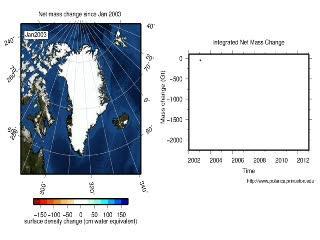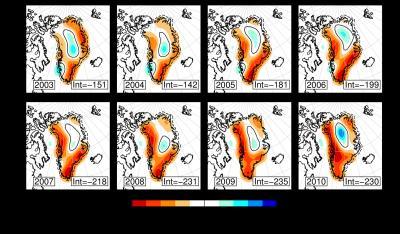Simons compared the noise that previously obscured a precise view of Greenland's glaciers to fog on a window. For a small area such as Greenland, the GRACE signal can be easily overwhelmed by noise, which has numerous causes such as the satellite's orbital position or even the type of mathematics researchers use to interpret data, Simons said.
"Other researchers used less than perfect tools to wipe off the window more or less indiscriminately and quite literally left streaks on the data. They were thus less able to put the continent into the proper focus," he said.
"We effectively modeled then removed noise to get the ice-loss signal out of the data," Simons said. "We then recovered relatively tiny variations in ice mass that to others might have looked like noise, but that to us were shown to be signal."
The Princeton researchers found that Greenland lost roughly 200 billion tons of ice each year during the seven-year period studied, which falls within the range reported by other studies. The amount of ice lost annually could stack up on all of Manhattan to nearly 12,000 feet, or more than eight times taller than the Empire State Building, Harig said.
As expected, ice loss occurred in the lower, warmer coastal areas — as opposed to the higher and colder interior, which gained ice mass — but the melt was concentrated on the southeast and northwest coasts for most of the period studied. Indeed, many coastal areas showed no ice-mass loss, while the ice sheet on the southwest coast actually thickened slightly from 2003 to 2006.
But these trends were more complex when Harig and Simons got into the details. Surprisingly, the location of the greatest melt activity migrated around the island, shifting from the southeast to the northwest coast in just a few years. Ice loss on the southeast coast built up starting in 2003 and hit a highpoint in 2007. In 2008, loss on this coast began to recede and shift toward the northwest coast; by 2010, the southeast coast displayed only minor ice loss, while nearly the entire western coast exhibited the most severe melt. During this transition, melt also receded then picked up again on the northeastern coast with seemingly little overlap with activity elsewhere.
Details such as these can help scientists better understand the interplay between Greenland's glaciers and factors that influence melt such as ocean temperature, daily sunshine and cloud coverage, Harig said. That understanding can in turn help researchers determine how the Greenland ice sheet responds to climate change — and how much more ice loss to expect. At current melt rates, the Greenland ice sheet would take about 13,000 years to melt completely, which would result in a global sea-level rise of more than 21 feet (6.5 meters), Harig said.
"Scientists are not totally sure what the driving force of the melt on Greenland is on short, yearly timescales," Harig said. "There is no certainty about which outside factor is the most important or if all of them contribute. Being able to compare what is happening regionally to field observations from other researchers of what a glacier is doing helps us figure out what is causing all this melt."
Michael Oppenheimer, Princeton's Albert G. Milbank Professor of Geosciences and International Affairs, said that the new level of detail Harig and Simons provide on Greenland's glaciers not only gives insight into what is causing the glaciers to melt, but what could possibly happen if they do.
Unlike water in a bathtub, sea-level rise is not uniform, said Oppenheimer, who is familiar with the research but had no role in it. Higher waters in certain locations may depend on which part of an ice sheet melts, he said. And determining which part of an ice sheet is melting the most requires precise details of ice loss and gain for specific glaciers — details that have largely been unavailable, Oppenheimer said.
"Nobody has really been able to take a look at an individual ice sheet and determine the influence that ice loss from different parts of that ice sheet could have on sea levels," Oppenheimer said.
"The details matter. Being able to pinpoint where and how much ice gain and loss there is tells you something about the driving forces behind it, and therefore how much we can expect in the future," he said. "A synoptic view at a high resolution is what GRACE always promised, and now this research has helped realize that potential. It's time to finally milk the data for as much detail as possible."
Harig is adapting the computer code — which is available online — to study GRACE data on ice loss in Antarctica and water accumulation in the Amazon River basin.
The paper, "Mapping Greenland's mass loss in space and time," was published online Nov. 19 in the Proceedings of the National Academy of Sciences. It was supported by a grant from the National Science Foundation.

Princeton University researchers developed an enhanced approach to capturing changes on the Earth's surface via satellite that could provide a more accurate account of how geographic areas change as a result of natural and human factors. In a first application, the technique brought the complexities of Greenland's massive ice sheet into clearer focus. From 2003 to 2012, the ice sheet experienced patchy fluctuations in ice loss and gain, while the areas of greatest melt gradually migrated from the southeast to the northwest coast.
(Photo Credit: Video by Christopher Harig)

From 2003 to 2010, Greenland overall lost roughly 200 billion tons of ice each year, but glacier activity was regionally inconsistent. Ice loss was concentrated on the southeast and northwest coasts for most of the period, but the area of greatest melt activity began to migrate from the southeast to the northwest coast around 2008. By 2010, the southeast coast displayed only minor ice loss. Meanwhile, the higher and colder interior gained ice mass, as did the southwest coast, slightly, from 2003 to 2006.
(Photo Credit: Image by Christopher Harig)
Source: Princeton University